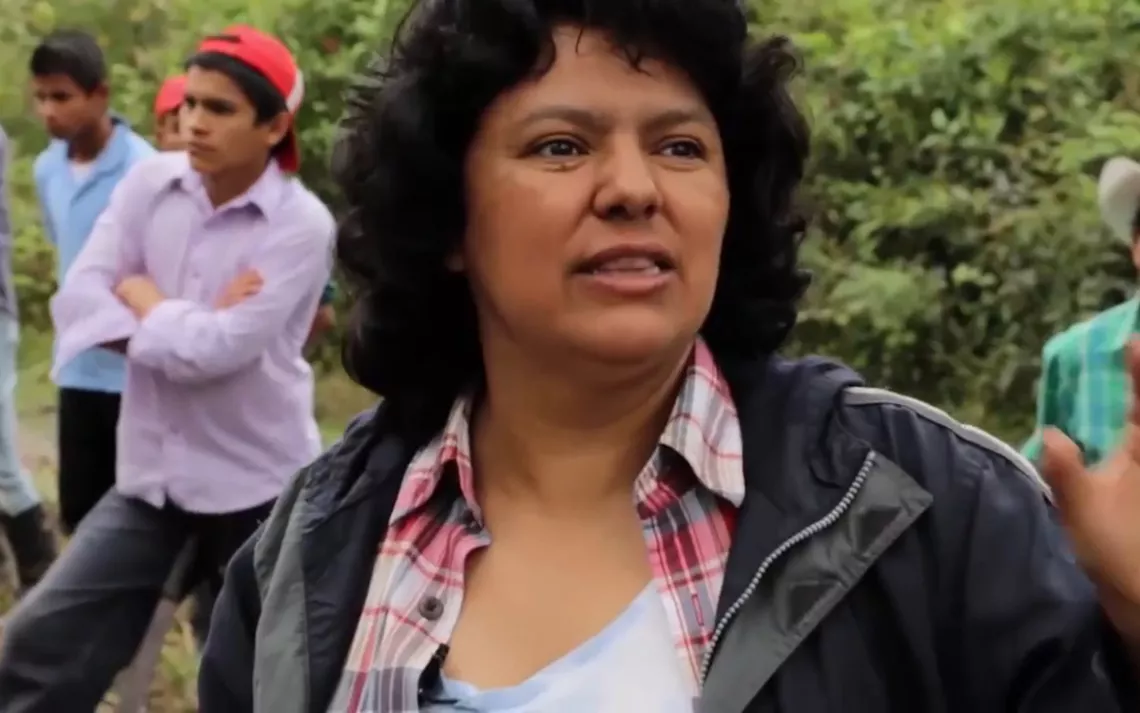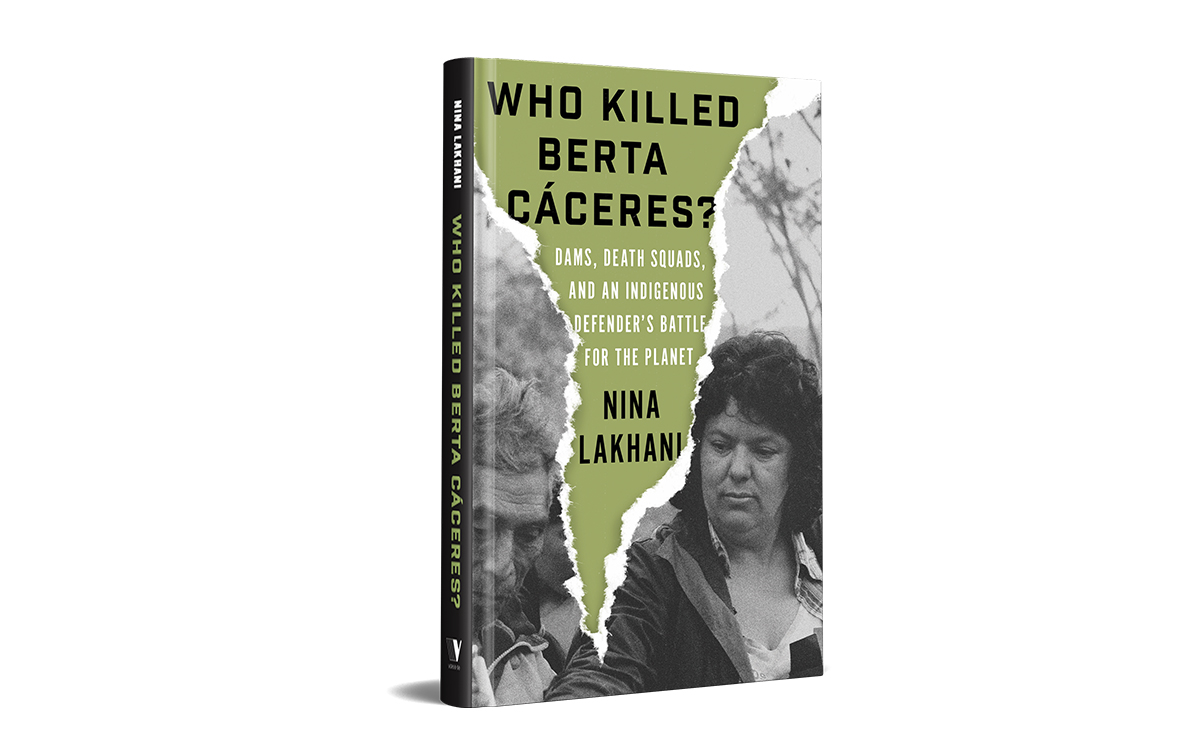The Many Murders of Berta Cáceres
A new book explores the story behind the murder

Photo by ONU Brasil/UN Environment/Champions of Earth 2017, de ONU Medio Ambiente
Once, when she was being arrested, Berta Cáceres told a police officer that she was a “professional agitator.” The cop, who had asked for her employment, refused to write that down. But Cáceres, true to form, insisted.
Cáceres spent her entire and cruelly shortened life dedicated to social struggle. She cofounded the Civic Council of Popular and Indigenous Organizations of Honduras (COPINH) to fight for Indigenous rights and territories. She fought for women’s liberation. She fought against the 2009 military coup in Honduras that overthrew President Manuel Zelaya. And she fought against the construction of a hydroelectric dam on the Gualcarque River.
Cáceres’s moral and physical courage earned her many friends, colleagues, and compañeros y compañeras in Honduras and all over the world. And it also earned her many enemies. On March 2, 2016, those enemies sent four gunmen to kick in her backdoor and shoot her in her bedroom. Gustavo Castro, a close friend and compañero, was staying with her that night, working in a bedroom across the hall. He narrowly survived a shot to the head.
“The physical murder of Berta Cáceres was the culmination of a process of many deaths. They had already been killing Berta Cáceres for some time when, late on March 2, 2016, they culminated that death process,” Ismael Moreno Coto told me in March 2017, when I traveled to Honduras to investigate Cáceres’s murder for Sierra. Moreno Coto, known as Padre Melo, is a Jesuit priest, radio journalist, and lead analyst with the human rights organization Reflection, Investigation, and Communication Workgroup.
Moreno said that Berta Cáceres was alternately stigmatized and ignored by the Honduran national media, discriminated against as a woman, repeatedly threatened, and falsely charged with illegal weapons possession and sedition before she was murdered. “What we see with Berta Cáceres,” he said, “is the Honduran model of the stages of death that social movement leaders experience before they are assassinated.”
What happens, then, when the very people implicated in carrying out those preliminary stages of death are the ones tasked with prosecuting the murder?
In her new book, Who Killed Berta Cáceres? (Verso, 2020), Guardian reporter Nina Lakhani asks a version of that question: “Could there ever be justice for someone like Berta in a country like Honduras, where impunity reigns supreme?”
The answer is an unequivocal no. Lakhani details how Honduras has become a “criminal state” where justice is almost impossible to come by. And she is clear that a portion of blame lies with the United States, which has been complicit in building a “counterinsurgency state” in Honduras during the “Cold War,” and overseeing its transformation into a “criminal state” by, among other things, then–Secretary of State Hillary Clinton’s support for the 2009 coup.
Lakhani is well equipped to tell the story of Cáceres’s life and murder. Lakhani covered Mexico and Central America for six years, and she first met Cáceres in 2013, while reporting on the struggle against the proposed dam on the Gualcarque River. The journalist then traveled back to Honduras in 2016 to cover Cáceres’s murder and subsequent trial in 2018. Along the way, she pulled off a number of scoops. In June 2016, for example, she reported that Cáceres had been on a military hit list of Honduran activists before she was killed. Lakhani, like Cáceres and many Honduran social movement leaders, was subsequently targeted in defamation campaigns.
Lakhani’s book is strongest when recounting her direct reporting on the murder investigation, and she hits her stride as she details the trial and the twists and turns of the court proceedings. In December 2018, after a five-week trial and more than a year since their convictions, seven men were sentenced for killing Berta Cáceres: four as material authors and three as intermediaries. (The four material authors were also convicted of attempting to murder Gustavo Castro.) At the last minute, however, the court barred Cáceres’s family and their lawyer from participating in the trial (their right under Honduran law). The prosecution then based its case on a small and selective amount of the evidence, fueling fears that the convictions could be overturned on appeal. (One of the intermediaries, Sergio Rodriguez, has already filed an appeal.)
Only one person has been charged as an intellectual author in the case. That’s David Castillo Mejía, a West Point graduate, former Honduran army intelligence officer, and the president of DESA, the company behind the proposal to build the dam on the Gualcarque River. According to a human rights report, Castillo’s biography is one of “violence, corruption, and impunity.” Although Castillo was arrested more than two years ago, he has yet to face trial.
Lakhani interviewed most of the accused in jail and attended the trial in Tegucigalpa. She also arranged to interview Castillo while he was in prison—though apparently without the subject’s prior consent. In the book, she describes a scene where Castillo is led into the prison warden’s office, sees Lakhani sitting at a table, recognizes her, and refuses to sit down. She recounts the scene as follows:
“‘I know who you are. You are the reason that I am in prison,’ [Castillo] said, not quite shouting but with voice raised and nostrils flared. ‘There is no way I am ever sitting down to talk to her,’ he snapped, looking at the warden.”
Lakhani tries to encourage him to tell her his side of the story, but he refuses, though he does linger in the doorway. Lakhani keeps asking him questions and challenging his answers.
[Castillo] “I paid for her mother’s medical treatment one or two months before she was murdered, my wife recommended the gynecologist, that’s the kind of relationship we had. I went to her house!”
[Lakhani] “You did go to her house, but you weren’t invited: That is called harassment. She was scared of you. How did you know where she was going to be all the time? You would turn up at malls, events, even the airport.”
It takes courage and intense self-control to remain calm and continue to press a powerful, former military intelligence officer accused of ordering political murder as Lakhani does here, and the scene is a testament to her powers as a watchdog journalist.
But Who Killed Berta Cáceres? isn’t without its flaws. While Lakhani’s book covers the essential elements of the story and gives a sense of the vitality, creativity, and brilliance of Berta Cáceres and the Honduran social movements in which she participated, the author all too often fails to go deeper than the language of summary, generalizations, and sound bites.
For example, at one point she writes, “Every conflict in Latin America is, at its heart, about land. Why? Because the distribution of land is directly linked to the distribution of wealth. In Honduras, both are scandalously unequal.” But is every conflict in Latin America really about land? What about, to take one example, women’s uprisings against feminicide in recent years? Platitudes and euphemistic abstractions like “the distribution of land is directly linked to the distribution of wealth” illuminate very little of the entrenched legacies of slavery, colonialism, and genocide in Honduras and throughout the region.
At another point, Lakhani writes, “the overlap between criminal gangs and the state can be so deep and so extensive that it’s hard to tell the good guys from the bad guys.” The language of “good guys” and “bad guys” in reference to “criminal gangs and the state” is often used by authorities to justify the “good” policing of “bad” criminals. But it’s a distinction that has always been at the service of those doing the very drug war policing that has had such murderous consequences all over Latin America.

In describing the 1994 national Indigenous mobilization that Cáceres and the COPINH organized, Lakhani writes, “It was the start of something, like a coming-out parade, which promoted the Indigenous people of Honduras from fossils to citizens.” The author surely doesn’t mean to argue that the 1994 mobilization literally “promoted the Indigenous people of Honduras from fossils to citizens,” but, unfortunately, that is what she writes.
The book also suffers from a dearth of citations. Lakhani rarely includes sources for historical information or factual claims, and when she does, her citations can be more frustrating than useful. For example, she writes at one point, “Matta’s airline company SETCO freely moved cocaine bound for US streets from Honduras to Mexico. In return, the State Department contracted SETCO to move weapons, ammunition and Contra fighters into Nicaragua between 1983 and 1985.” The entire text of her citation footnote reads, “See presidency.ucsb.edu.” That incomplete URL simply takes readers to the homepage of the American Presidency Project at UC Santa Barbara.
In general, however, Lakhani’s book succeeds in calling attention to the multiple levels of local and international complicity in building a state that murders and gets away with it. And her coverage of the trial reveals the trial’s true intent: “From the way in which the lawyers were expelled, after having been repeatedly denied information and blocked from making their case, it was hard not to conclude that concealing the truth was exactly the point.”
I recently asked Karen Spring, a Canadian activist with the Honduras Solidarity Network who has lived in the country since the 2009 coup, what she thought the impact of the trial has been on social movements. “Honduras is a dictatorship,” she reminded me. “When I was attending the trial, I kept thinking, 'This is a joke. The government is going to convict these people because it has to because of international pressure.' But this is a dictatorship: That is the elephant in the room.”
Who Killed Berta Cáceres? shows readers that elephant. And it is here, especially considering the US role in supporting that dictatorship, that we could do much more to better understand and act in solidarity with Honduran social movements to prevent the continuation of the many deaths of Berta Cáceres and the continued persecution of others still fighting for justice.
 The Magazine of The Sierra Club
The Magazine of The Sierra Club



